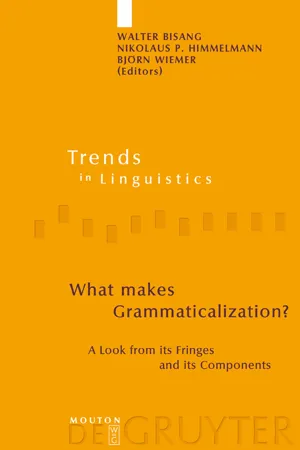
eBook - PDF
What makes Grammaticalization?
A Look from its Fringes and its Components
- 360 pages
- English
- PDF
- Available on iOS & Android
eBook - PDF
What makes Grammaticalization?
A Look from its Fringes and its Components
About this book
The status of grammaticalization has been the subject of many controversial discussions. The contributions to What makes Grammaticalization? approach the prevalent phenomenon from the angle of language structure and focus on the interrelation between the levels of phonology, pragmatics (inference), discourse and the lexicon and some of them try to integrate the areal perspective. A wealth of data from Slavonic languages as well as from languages of other genetic and areal affiliation is discussed. The book is of interest to linguists specializing in grammaticalization, lexicalization and morphological typology, to language typologists as well as to functional, historical and cognitive linguists.
Frequently asked questions
Yes, you can cancel anytime from the Subscription tab in your account settings on the Perlego website. Your subscription will stay active until the end of your current billing period. Learn how to cancel your subscription.
At the moment all of our mobile-responsive ePub books are available to download via the app. Most of our PDFs are also available to download and we're working on making the final remaining ones downloadable now. Learn more here.
Perlego offers two plans: Essential and Complete
- Essential is ideal for learners and professionals who enjoy exploring a wide range of subjects. Access the Essential Library with 800,000+ trusted titles and best-sellers across business, personal growth, and the humanities. Includes unlimited reading time and Standard Read Aloud voice.
- Complete: Perfect for advanced learners and researchers needing full, unrestricted access. Unlock 1.4M+ books across hundreds of subjects, including academic and specialized titles. The Complete Plan also includes advanced features like Premium Read Aloud and Research Assistant.
We are an online textbook subscription service, where you can get access to an entire online library for less than the price of a single book per month. With over 1 million books across 1000+ topics, we’ve got you covered! Learn more here.
Look out for the read-aloud symbol on your next book to see if you can listen to it. The read-aloud tool reads text aloud for you, highlighting the text as it is being read. You can pause it, speed it up and slow it down. Learn more here.
Yes! You can use the Perlego app on both iOS or Android devices to read anytime, anywhere — even offline. Perfect for commutes or when you’re on the go.
Please note we cannot support devices running on iOS 13 and Android 7 or earlier. Learn more about using the app.
Please note we cannot support devices running on iOS 13 and Android 7 or earlier. Learn more about using the app.
Yes, you can access What makes Grammaticalization? by Walter Bisang,Nikolaus P. Himmelmann,Björn Wiemer in PDF and/or ePUB format, as well as other popular books in Filología & Lingüística histórica y comparativa. We have over one million books available in our catalogue for you to explore.
Information
Table of contents
- Frontmatter
- Contents
- What makes grammaticalization? An appraisal of its components and its frings
- Lexicalisation and grammaticalization: Opposite or orthogonal?
- Exploring grammaticalization from below
- Grammaticalization v. pragmaticaliuation? The development of pragmatic markers in German and Italian
- Grammaticalization without coevolution of form and meaning: The case of tense-aspect in East and mainland Southeast Asia
- The rise of an indefinite article: The case of Macedonian eden
- Grammaticalization via extending derivation
- Grammaticalization the derivational way: The Russian aspectual prefixes po-, za-, ot-
- The role of predicate meaning in the devekopment of reflexivity
- Modals and the boundaries of grammaticalization: the case of Russian, Polish and Serbian-Croatian
- The evolution of passives as grammatical constructions in Northern Slavic and Baltic languages
- Backmatter